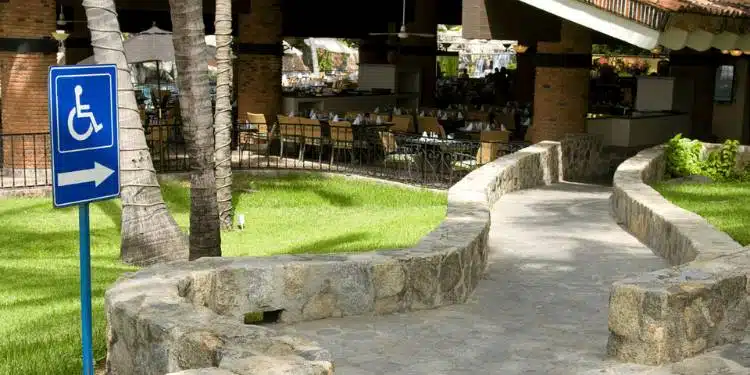Life With a Mobility Disability
According to the WHO (World Health Organization), there are an estimated 3.3 million wheelchair users in the United States. Approximately 1.825 million are aged 65 and older. My Mom was one of them. Life became exponentially more difficult for her after a car accident left her without the use of her legs.
It was then I realized the world was not set up to be inclusive for people who used wheelchairs. I am embarrassed to admit that before Mom’s accident, I was oblivious to the challenges those with any type of mobility disability faced regularly. Finding venues where we could easily and comfortably go was difficult. It required hours of research to find locations with accessible entries, restrooms, parking, and elevator access. The simplest outing became an ordeal.
Accessibility for All Regardless of Whether You Walk or Roll
Unfortunately, I did not find the world to be wheelchair friendly for the most part. What I saw were hotels boasting accessibility that perhaps had a grab bar over the tub. Mom couldn’t get into a tub. Or restaurants claiming to be wheelchair friendly that had wide doorways and accessible seating, but the tiny restroom was two steps down at the back of the restaurant. The lives of people in wheelchairs are difficult enough daily without all these additional obstacles. Easy access is taken very much for granted by most able-bodied people. I get that as I was one of them until I experienced the difficulties with my Mom.

Google Maps “Accessible Places” to the Rescue
When traveling to a new location with a wheelchair, it’s incredibly helpful to know what to expect in terms of accessibility to your destination. To help provide the necessary information, Google Maps created “Accessible Places” in 2017, an incredibly helpful feature. Pictures and reviews from others can provide great insight for those traveling with a chair. Store owners also helped.
In 2020, Google implemented even more features to help you choose the most accessible destinations and is available on both Android and IOS smartphones. When “Accessible Places” is switched on, you’ll be able to easily see if a place offers accessible seating, restrooms, or parking. If it is confirmed a location does not have an accessible entrance, that information is provided too on the app.
Google Maps Local Guides program encourages users and business owners to contribute detailed information about locations in their communities. This crowdsourced data helps improve the accuracy of the accessibility facts provided, With this information, the accessibility of locations is rated on a scale of 1 to 5 for the use of other Google Maps users. More than 500 million reviewers contributed since the activation of “Accessible Places” on Google Maps in 2017. This data helps make life simpler and easier for wheelchair users.
How to use Google Maps’ “Accessible Places” feature
Here’s how to find wheelchair-accessible locations using Google Maps. But before using Accessible Places, make sure you have the latest version of Google Maps downloaded.
To turn on “Accessible Places”
1. Start by tapping on your profile icon in Google Maps (usually a round icon in the top-right corner).
2. Next, click on “settings”, scroll down, and select “accessibility” on the new screen showing the list of all settings.
3. You will see “Accessible places”. Toggle it on to show if places have wheelchair-accessible features when searching or viewing a location.
You are ready to start searching!
Using “Accessible Places”
1. Open the Google Maps app on your mobile device or go to the Google Maps website on your computer.
2. Search for the location you want to visit or navigate to.
3. Once the location appears on the map, tap on it or click on it to open the location details.
4. Scroll down until you see the “Accessibility” section. If there is no “Accessibility” section, it means that the location has not yet been rated for accessibility.
5. In the “Accessibility” section, you will see a rating from 1 to 5 that indicates how accessible the location is. You can also see more detailed information about the accessibility features of the location, such as whether it has wheelchair-accessible entrances, parking spaces, restrooms, and elevators.
6. You can also contribute to the accessibility information by rating the location or adding details about its accessibility features. To do this, tap on the “Suggest an edit” button and provide the necessary information.
7. Once you checked the accessibility information of the location, you can use Google Maps to get directions to the location or navigate around it using the map.
By using this feature on Google Maps, you can easily find and visit locations that are accessible to people with disabilities.
Who Else Can Benefit From “Accessible Places”
The list is endless. This app is beneficial not only for those who use wheelchairs but also for those with limited mobility for whatever reason. It is a great tool for those with a temporary disability too, such as a broken leg or following knee surgery. And let’s not forget about parents with strollers and other accouterments. The reality is that all venues should be built with universal design principles in mind to ensure easy access for everyone.
Google Maps’ “Accessible Places” Helps Promote Inclusivity
Google Maps’ “Accessible Places” feature helps to promote inclusivity and accessibility for all users, regardless of their physical abilities. I wish this feature was available when I cared for my Mom as her world became small due to her limitations.
I appreciate the creation of “Accessible Places” for the many who need it. It is wonderfully designed to help people with disabilities or mobility impairments to find accessible places such as wheelchair ramps, accessible entrances, restrooms, and parking. This feature even allows users to filter their search results on Google Maps to show only places that are accessible. By using the Google Maps “Accessible Places” feature, users can save time and avoid frustration by knowing in advance whether a place is accessible or not.
Please share this post as many people are not aware of this Google Maps feature. Everyone needs to know how to find wheelchair-accessible locations using Google Maps!

FAQs About Google Maps “Accessible Places”
Below are some commonly asked questions about Google Maps Accessible Places
What is Google Maps’ “Accessible Places”?
Google Maps’ “Accessible Places” refers to locations that are easily accessible to people with disabilities. These locations have features and facilities designed to accommodate individuals with mobility, vision, hearing, or cognitive impairments, making it easier for them to navigate and enjoy their visit.
How does Google Maps identify accessible places?
Google Maps identifies accessible places through a combination of user-contributed information, data from business owners, and third-party sources. Google encourages users to provide accessibility information for places they visit. Additionally, business owners can add accessibility details to their listings, and Google may also use data from other organizations that focus on accessibility.
What type of accessibility information is available on Google Maps for places?
The accessibility information available on Google Maps includes details about wheelchair accessibility, whether a location has accessible entrances, restrooms, and parking spaces, whether there are elevators or ramps, and more.
How can users find accessible places on Google Maps?
Users can find accessible places on Google Maps by searching for a specific location and looking for the wheelchair icon, which indicates that the place is marked as accessible. They can also apply the “Accessible places” filter when searching for specific types of locations, like restaurants or hotels, to find better accessibility options.
Can users contribute to accessibility information on Google Maps?
Certainly, users may contribute to accessibility information on Google Maps. They can add details about accessibility for places they visited, such as whether there are ramps, accessible restrooms, or designated parking spaces. This user-contributed information helps others to plan their trips more effectively.
Are there any guidelines for adding accessibility information on Google Maps?
Yes, Google provides guidelines for adding accessibility information to ensure accurate and helpful details. Users should add information only about places they visited, and provide specific and accurate details in their descriptions. The information should focus on accessibility features relevant to people with disabilities.
Can business owners add accessibility information for their establishments on Google Maps?
Absolutely. Business owners can add accessibility information for their venues by claiming their business listing on Google My Business. After claiming their listing, they can go to the “Info” section to select the accessibility options that apply to their location, such as wheelchair-accessible entrances and restrooms.
Is Google Maps available in multiple languages for accessibility information?
Yes, accessibility information found through Google Maps is offered in various languages. This way, users with different language preferences can access the information they need to plan their visits to accessible places.
How reliable is the accessibility information on Google Maps?
The reliability of accessibility information on Google Maps depends on the contributions of users and business owners. Google encourages users to provide accurate information based on their actual experiences, and business owners are responsible for maintaining the accuracy of the accessibility details they add to their listings. It’s not a perfect system. As Google attempts to verify the information, we recommend users cross-reference and verify details when planning a visit to an accessible place.
Related Articles
More Accessibility Resources
Worry-Free Travel for Those With Disabilities
18 Beautiful Grab Bars (Not Your Grandmother’s Grab Bars)










